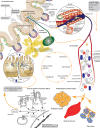Impaired Intestinal Barrier and Tissue Bacteria: Pathomechanisms for Metabolic Diseases
- PMID: 33767669
- PMCID: PMC7985551
- DOI: 10.3389/fendo.2021.616506
Impaired Intestinal Barrier and Tissue Bacteria: Pathomechanisms for Metabolic Diseases
Abstract
An intact intestinal barrier, representing the interface between inner and outer environments, is an integral regulator of health. Among several factors, bacteria and their products have been evidenced to contribute to gut barrier impairment and its increased permeability. Alterations of tight junction integrity - caused by both external factors and host metabolic state - are important for gut barrier, since they can lead to increased influx of bacteria or bacterial components (endotoxin, bacterial DNA, metabolites) into the host circulation. Increased systemic levels of bacterial endotoxins and DNA have been associated with an impaired metabolic host status, manifested in obesity, insulin resistance, and associated cardiovascular complications. Bacterial components and cells are distributed to peripheral tissues via the blood stream, possibly contributing to metabolic diseases by increasing chronic pro-inflammatory signals at both tissue and systemic levels. This response is, along with other yet unknown mechanisms, mediated by toll like receptor (TLR) transduction and increased expression of pro-inflammatory cytokines, which in turn can further increase intestinal permeability leading to a detrimental positive feedback loop. The modulation of gut barrier function through nutritional and other interventions, including manipulation of gut microbiota, may represent a potential prevention and treatment target for metabolic diseases.
Keywords: adipose tissue microbiota; endotoxemia; intestinal permeability; metabolic disease; microbiome; obesity; type 2 diabetes; zonulin.
Copyright © 2021 Massier, Blüher, Kovacs and Chakaroun.
Conflict of interest statement
The authors declare that the research was conducted in the absence of any commercial or financial relationships that could be construed as a potential conflict of interest.
Figures

Similar articles
-
Gut Microbiome, Intestinal Permeability, and Tissue Bacteria in Metabolic Disease: Perpetrators or Bystanders?Nutrients. 2020 Apr 14;12(4):1082. doi: 10.3390/nu12041082. Nutrients. 2020. PMID: 32295104 Free PMC article. Review.
-
A Cascade of Microbiota-Leaky Gut-Inflammation- Is it a Key Player in Metabolic Disorders?Curr Obes Rep. 2025 Apr 10;14(1):32. doi: 10.1007/s13679-025-00624-0. Curr Obes Rep. 2025. PMID: 40208464 Review.
-
Leaky Gut: Effect of Dietary Fiber and Fats on Microbiome and Intestinal Barrier.Int J Mol Sci. 2021 Jul 16;22(14):7613. doi: 10.3390/ijms22147613. Int J Mol Sci. 2021. PMID: 34299233 Free PMC article. Review.
-
Exploiting the Zonulin Mouse Model to Establish the Role of Primary Impaired Gut Barrier Function on Microbiota Composition and Immune Profiles.Front Immunol. 2019 Sep 19;10:2233. doi: 10.3389/fimmu.2019.02233. eCollection 2019. Front Immunol. 2019. PMID: 31608059 Free PMC article.
-
Faecalibacterium prausnitzii-derived microbial anti-inflammatory molecule regulates intestinal integrity in diabetes mellitus mice via modulating tight junction protein expression.J Diabetes. 2020 Mar;12(3):224-236. doi: 10.1111/1753-0407.12986. Epub 2019 Oct 30. J Diabetes. 2020. PMID: 31503404 Free PMC article.
Cited by
-
The Gut Microbiota of Pregnant Rats Alleviates Fetal Growth Restriction by Inhibiting the TLR9/MyD88 Pathway.J Microbiol Biotechnol. 2023 Sep 28;33(9):1213-1227. doi: 10.4014/jmb.2304.04020. Epub 2023 Jun 30. J Microbiol Biotechnol. 2023. PMID: 37416999 Free PMC article.
-
Exploring the multifactorial aspects of Gut Microbiome in Parkinson's Disease.Folia Microbiol (Praha). 2022 Oct;67(5):693-706. doi: 10.1007/s12223-022-00977-2. Epub 2022 May 18. Folia Microbiol (Praha). 2022. PMID: 35583791 Free PMC article. Review.
-
Effect of High-Fat and Low-Fat Dairy Products on Cardiometabolic Risk Factors and Immune Function in a Low Birthweight Swine Model of Diet-Induced Insulin Resistance.Front Nutr. 2022 Jun 17;9:923120. doi: 10.3389/fnut.2022.923120. eCollection 2022. Front Nutr. 2022. PMID: 35782930 Free PMC article.
-
Dietary Supplement, Containing the Dry Extract of Curcumin, Emblica and Cassia, Counteracts Intestinal Inflammation and Enteric Dysmotility Associated with Obesity.Metabolites. 2023 Mar 9;13(3):410. doi: 10.3390/metabo13030410. Metabolites. 2023. PMID: 36984850 Free PMC article.
-
Cardiovascular protective effects of natural flavonoids on intestinal barrier injury.Mol Cell Biochem. 2025 Jun;480(6):3343-3362. doi: 10.1007/s11010-025-05213-2. Epub 2025 Jan 17. Mol Cell Biochem. 2025. PMID: 39820766 Review.
References
Publication types
MeSH terms
LinkOut - more resources
Full Text Sources
Other Literature Sources
Medical

